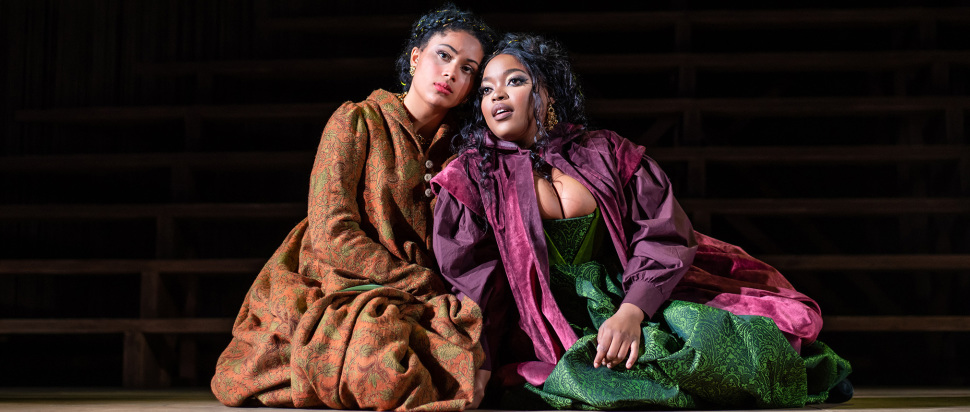Laurie Sansom on James IV: Queen of the Fight
Director Laurie Sansom discusses racism and royalty in James IV: Queen of the Fight on the eve of its Scottish tour
As the fourth play in Rona Munro’s James plays, James IV: Queen of the Fight focuses on the inaugural performance of William Dunbar’s staggeringly racist poem, Of Ane Black Moir (About a Black Moor) at the court of Scottish king James IV in the early 1500s. The poem, called “shockingly racist” by medievalist Karl Steel, details in deeply unsettling terms how the object of the poem – a Black woman, newly brought to Scotland – differs physically from her white counterparts. The translated title of the poem is sometimes referenced as 'My lady with the large lips', and it paints a clear picture of some of the earliest iterations of anti-Blackness in Scotland. The poem utilises many of the racist tropes we still see in play today. In it, Dunbar points out ('praises' is definitely not the right word) the subject’s 'exaggerated' features – it is disturbing enough to read it, let alone to hear it spoken aloud.
However, Munro’s most recent James play requires the audience to do just that. Director Laurie Sansom, who has been with the project since its inception, says that he hopes the story will “move people, make them talk about it.” Sansom is hoping that the raw depiction of racism in the play will contribute to the national discussion about racism in Scotland. “I think it's calling out a kind of Scottish exceptionalism that likes to think it's open and fair and equitable,” he says. “We know that, of course, there are other currents running underneath that.” Sansom is hoping that non-Black theatregoers are willing to interrogate their own biases, and confront in greater detail Scotland’s long history with racist violence.
Performing this poem is a tall order for the show’s company, as well. Sansom says: “It was probably the hardest thing to get right. At the heart of the story, you have this horrible poem full of racist slurs, and it’s one of the key beats that we're leading up to. It's actually a very difficult thing to bring into the room, even in rehearsal – to have to hear those words and ask people to engage and respond to it.” Sansom talks about striking a balance between giving the poem context and power, while also allowing the play to showcase joy and complexity. He doesn’t want the poem to be “reduced to one utterance”, because it isn’t just a one-off incident. The sentiments in Dunbar’s poem are still echoed today. They can be found in beauty ads, social media trends, and reality television – they are very much a part of our modern spectacle.
However, Sansom hopes that the play can cut through all this context to deliver a meaningful, character-led drama. According to Sansom, James IV is not like other history plays. It is, at its heart, a deeply personal drama about performances of power. Especially in the wake of the death of Queen Elizabeth II (James IV’s great-great-great-great-great-great-great-great-great-great-great-great-great-granddaughter), Sansom hopes that the play can provide a timely examination of public and private power – how it is signified, held, and enforced. In James IV, we see the threads of white supremacy in royal rule enacted on a Black woman. But with a predominantly non-Black creative team, how deeply must a play dive to tell a faithful and constructive story about anti-Blackness?
The question is, as always, who gets to be the subject? To be a subject is not just to have the play be 'about' you – it is to have agency and authority, to be liberated in the context of the story. In Dunbar’s poem, the Black woman is, quintessentially, an object. She is offered up for scrutiny, even ridicule. There is something in the project of James IV that hopes to go beyond pointing out that 'racism = bad'. In its ideal interpretation, the play should interrogate the conditions that enable (and even celebrate) such abject oppression.
“It looks like the play is responding to a very particular moment in time,” Sansom says. “But I think what happens is that, if you write honestly about people, you always end up talking about what's going on in the world right now.” Sometimes, theatre-makers make the mistake of thinking that because their work is 'about people', it doesn’t necessarily have to confront context head-on. Sansom and his team took steps in the rehearsal room to mitigate the eliding effect of adaptation, but it’s hard not to wonder about who really 'owns' the project. Especially because James IV sits in the midst of an ongoing trilogy about Scottish royalty, Dunbar’s egregious racism runs the risk of feeling like a feature of a broader history, rather than a current – and urgent – threat. Something feels out of touch about the wish to balance education with entertainment. After all, Sansom says, he also wants to give audiences “a really good night out” on top of everything else.
It feels like Sansom’s wishes are targeted at primarily white audiences, at theatre-goers who need to be asked politely to confront racism, rather than those who are confronted with it on a daily basis. I’m not here to make a value judgement on plays about racism by predominantly white creative teams, but I think that the success of the James plays, including James IV’s upcoming Scottish tour, speaks to who is welcome to tell these stories in Scotland and who remains an object.
James IV: Queen of the Fight, touring Inverness and Stirling until 12 Nov
nationaltheatrescotland.com/events/james-iv-queen-of-the-fight
